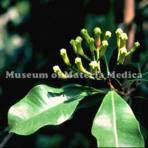Clove

|
Market name:丁子 Photo location:Museum of Materia Medica, Inst. of Nat. Med. TMPW No.:8025 |

|
Plant name:Syzygium aromaticum Photo location:Toyama Pref., Japan Photo date:1988 Photographer:K. Komatsu |
| Synonym | |
| Latin name | Caryophylli Flos |
| Botanical source: Family name | Myrtaceae |
| Botanical source: Plant name | Syzygium aromaticum Merrill et L.M.Perry (IPNI:601421-1) |
| Part used | Flower bud |
| Empirical criteria for quality selection | Good one is enlarged and brick-red. It sinks under water. (TN) |
| Constituents | Lipids: Fatty oil Sesquiterpenoids: α-Caryophyllene, β-Caryophyllene, Humulene, Carophylla-4(12), 8(13)-dien-5β-ol, Carophylla-3,8(13)-dien-5α-ol Triterpenoids: Oleanolic acid, Methyl-2α-hydroxyoleanoate Sterols: Stigmasterol, Sitosterol, Campesterolyglucoside Phenylpropanoids: Eugenol, Acetyleugenol, Chavicol, Eugenol salicylate Chromones: Eugenin, Eugenitin, Isoeugenitin, Isoeugenitol, Eugenoside I, Eugenoside II Flavones & Flavonols: Kaempferol, Rhamnetin Tannins: Eugeniin, 1-Desgalloyleugeniin, 2-Desgalloyleugeniin Other aromatic compounds: Furfural Phenol derivatives: Vanillin Isoquinoline alkaloids: Higenamine |
| Pharmacological effects | Sedation, transient decrease in blood pressure, uterine contraction, local anesthesia, antibacterial (clove oil, eugenol: Brucella, Mycobacterium avium, Trichophyton, Achorion, Inguinal Epidermophyton). |
| Indications | As an aromatic stomachic, it is applied to treat relieve gastric weakness, vomiting, and abdominal pain. It is used as a bactericide, preservative and spice (gargle or toothpaste). It is also an important material for domestic medicine and clove oil. |
| Diseases | Hiccup, Vomitting, Anorexia, Nausea, Diarrhea, Upper & lower abdominal pain, Hernia, Leukorrhea |
| Formulas | shiteito , chokoshiteito , jidabokuippo , nyoshinsan |
| Meridian tropism | Lung, Stomach, Spleen, Kidney |
| Property | Warm |
| Flavor | Acrid/pungent |
| Classification in "Shen-non Ben-cao Jing" | |
| TCM: Classification | Drugs for dispelling internal cold |
| TCM: Medicinal effects | To warm the spleen and stomach, to regulate the adverse flow of the stomach qi, and to restore the kidney yang.: For hiccup, vomiting, anorexia, diarrhea, epigastric and abdominal pain with cold sensation in deficiency-cold syndromes of the spleen and stomach, and impotence due to deficiency of kidney yang. |
| Remarks | Listed in the Japanese Pharmacopoeia 18th ed. |
| References | TN: T. Namba & Y. Tsuda ed., Outline of Pharmacognosy, a Textbook, 3rd ed., Nankodo Co., Ltd., Tokyo, 1998. |
DNA sequences of medicinal plants
| Gene Region | |||||||||||||||||||
| Nuclear | Chloroplast | Mitochondria | |||||||||||||||||
| Botanical source: Plant name | 5Ss | 18S | ITS1 | 5.8S | ITS2 | 26S | others | trnH-psbA | matK | trnK | trnK-rps16 | trnT-L | trnL | trnL-F | rbcL | rpoC1 | ndhF | others | |
|
|
|||||||||||||||||||
